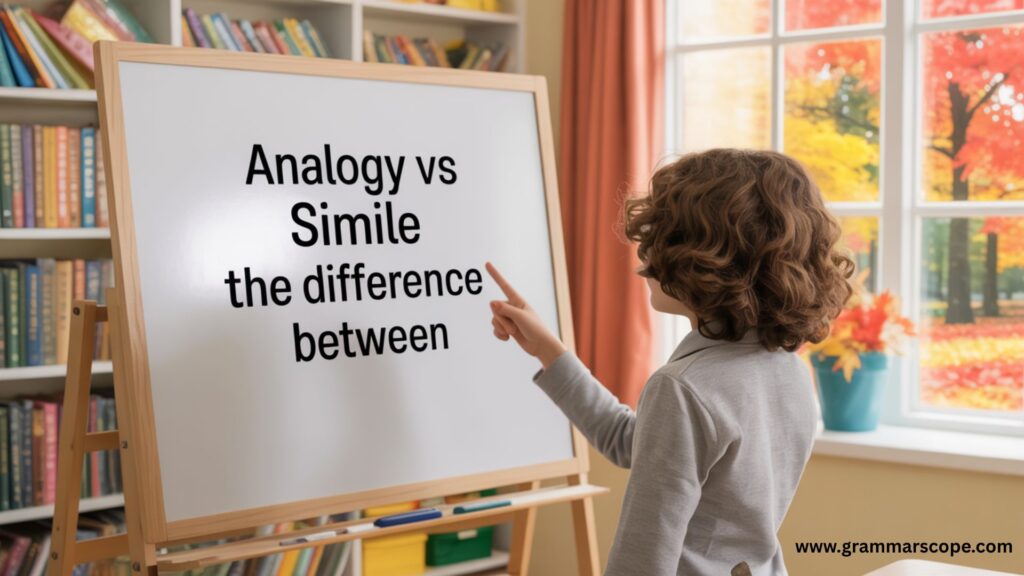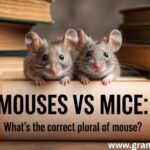Analogy vs Simile the Difference Between can elevate your writing and communication skills. While both belong to the family of figurative language, they serve distinct purposes and are structured differently. Ever tried explaining a confusing idea to a friend and said, “It’s kind of like” Congratulations you just used either a simile or an analogy. But which one? The two often hang out in the same neighborhood of language, wearing similar outfits, but they’re not the same. Think of a simile as a snapshot quick, vivid, and to the point. An analogy, on the other hand, is more like a full on movie scene, stretching out the comparison to teach or clarify. Both tools help us paint pictures with words. But knowing when to use which? That’s where things get interesting.
Why Knowing the Difference Between Analogy and Simile Matters
Precision matters in writing. Choosing the wrong figurative device can muddle your message or confuse your audience. Whether you’re drafting a persuasive argument, crafting fiction, or explaining a complex idea, using the right comparison tool at the right moment makes all Analogy vs Simile the Difference Between.
What Is a Simile and How Does It Work?
A simile is a direct comparison between two different things, usually using the words “like” or “as.” It helps paint vivid mental images, making writing more engaging and descriptive. Similes often appeal to the senses, helping readers visualize, hear, or feel what the writer intends.
Consider the sentence Her laugh was like music. This simile draws a comparison to music, suggesting that her laugh is melodious and pleasant.
Similes are especially effective in storytelling and poetry, where imagery is essential. They’re straightforward, making them accessible and widely used even in everyday speech.
What Is an Analogy and What Makes It Powerful?
An analogy is a more elaborate comparison that explains the relationship between two things. It often aims to clarify complex ideas by comparing them to something familiar. Unlike similes, analogies don’t just create imagery they build understanding.
Take the analogy, “Just as a lamp lights a room, education illuminates the mind.” Here, the comparison deepens understanding of the value of education by relating it to a tangible experience.
Analogies are common in education, science, and persuasive writing. They make abstract concepts easier to grasp and are often used to explain unfamiliar subjects in relatable ways.
Key Differences Between Analogy and Simile
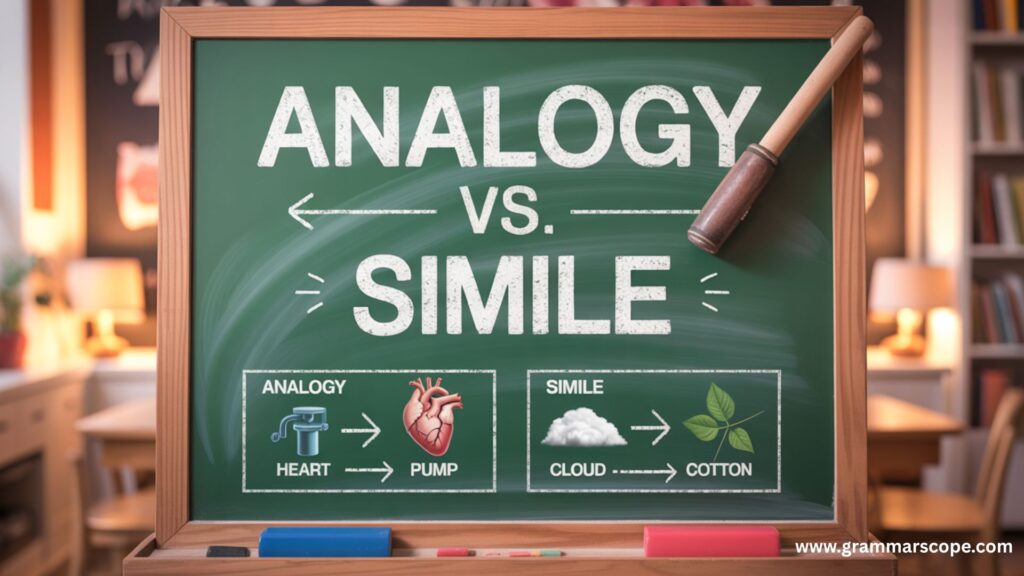
Though both devices involve comparisons, their intent and depth differ significantly. A simile draws a surface level comparison for effect, while an analogy delves deeper to explain relationships and ideas.
Similes are concise and image-driven. They quickly paint a picture. Analogies, however, are structural and logicdriven. They require more explanation and often span several lines or sentences.
Where similes rely on sensory language, analogies depend on reason. A simile might describe how something looks or feels, whereas an analogy reveals how things function or relate.
How to Instantly Identify a Simile or an Analogy
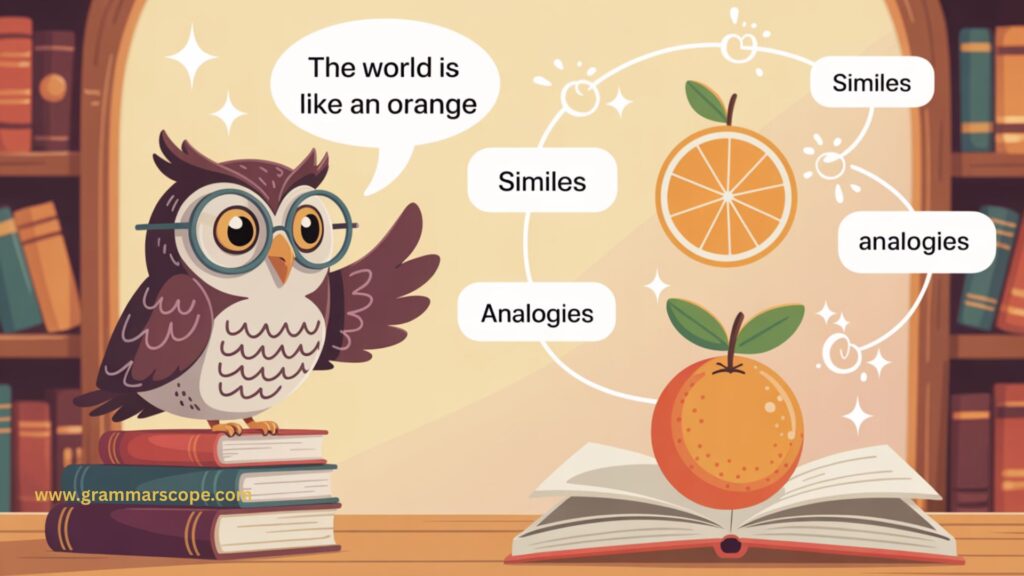
Start by asking why the comparison is being made. If the goal is to create a vivid image, it’s likely a simile. If the goal is to clarify a complex idea or relationship, it’s probably an analogy.
Next, look at the structure. Similes usually include “like” or “as” and are limited to a single sentence. Analogies may use similes or metaphors as part of their structure but extend the comparison to emphasize logical connections.
Real World Examples of Simile and Analogy in Action
Simile: “He ran like the wind.”
This creates an image of someone running quickly, emphasizing speed through sensory comparison.
Analogy: “He navigated the corporate world like a seasoned captain steering through stormy seas.”
This provides insight into the person’s experience and leadership skills, using an extended metaphor to draw a comparison with deeper meaning.
Common Pitfalls When Using Similes and Analogies
Writers sometimes confuse long similes for analogies. Length doesn’t determine the type of figurative language purpose does. If the comparison is explanatory, it’s an analogy, regardless of length.
Another mistake is overusing similes in formal writing. While they can be vivid, too many can make writing feel exaggerated or informal.
Using analogies for simple concepts can also backfire. If the comparison is more complex than the idea it’s trying to clarify, it only adds confusion.
How to Choose Between Simile and Analogy in Your Writing
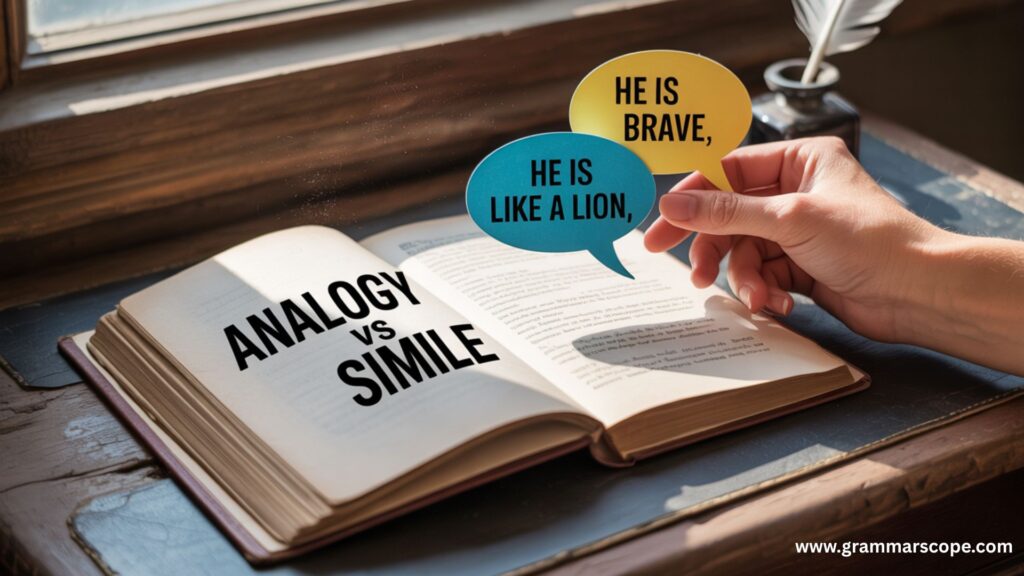
Choose a simile when you want to enhance descriptions or create vivid imagery. They’re ideal for creative writing, poetry, and informal contexts.
Use an analogy when you’re trying to explain or persuade. They work well in academic essays, technical writing, and any situation where clarity is essential.
Sometimes, combining the two can be powerful. Starting with a simile and then expanding into an analogy can offer both sensory appeal and explanatory depth.
Quick Comparison of Analogy and Simile Characteristics
Similes are brief and sensory based, while analogies are extended and logical. Similes use “like” or “as” and aim for effect. Analogies often use entire scenarios to explore relationships and improve understanding.A simile is a short, direct comparison that uses words like “like” or “as” to highlight a similarity between two different things. It’s often used to create a vivid mental image. For instance, saying “Her smile is like sunshine” quickly gives the reader a sense of warmth and brightness, without going into detail. Similes are typically brief, poetic, and often show up in creative writing or casual speech to add color and feeling.
An analogy, on the other hand, is more than just a quick comparison it’s a tool used to explain or clarify a concept by drawing a deeper, often logical connection between two things. While a simile might spark a moment of recognition, an analogy guides the reader through a fuller idea. Take this analogy, for example: “The human brain works like a computer’s hard drive it stores information, retrieves data, and sometimes crashes under too much stress.” It’s not just poetic; it’s educational.
Similes tend to stay on the surface, offering a figurative resemblance between two things, while analogies dig deeper, highlighting the function or relationship between them. Similes are like snapshots, quick and expressive. Analogies are more like stories they unfold, explain, and persuade.
Frequently Asked Question
What exactly is the difference between an analogy and a simile?
At their core, both analogy and simile are comparison tools, but they serve different purposes and operate in distinct ways. An analogy takes two seemingly unrelated things and draws a connection by explaining how they share a similar relationship, function, or structure. It often provides a more thorough explanation, helping to clarify complex or abstract ideas by relating them to something familiar. Similes, by contrast, use the words “like” or “as” to create a direct, vivid comparison between two things based on a particular characteristic or quality. While an analogy might stretch across multiple sentences or even paragraphs to unpack an idea, a simile typically offers a quick snapshot meant to spark imagination or emotional resonance.
Can you provide a straightforward example of an analogy?
Certainly! Imagine you want to explain how the brain works to someone unfamiliar with neuroscience. You might say, “The brain functions like a computer’s CPU, processing and directing information.” This analogy connects the complex workings of the brain to something most people understand the central processing unit of a computer highlighting their shared role in managing tasks and data. The purpose is to illuminate the unfamiliar by comparing it to the familiar, making the concept easier to grasp.
How do similes improve or enhance writing?
Similes add a layer of color and emotion to writing by creating sharp, relatable images that resonate with readers. When a writer says, “Her laughter was like the tinkling of bells,” they aren’t just describing sound; they’re evoking a delicate, joyful feeling that’s easy to picture and almost hear. This technique helps paint vivid scenes or express feelings quickly and effectively. Because similes hinge on sensory or emotional qualities, they can transform bland or abstract descriptions into lively, memorable moments.
Are analogies limited to scientific or technical writing, or do they appear elsewhere?
While analogies are indispensable in scientific and technical contexts for breaking down complicated subjects, they’re hardly confined to those areas. People use analogies in everyday conversations to clarify ideas, in literature to build thematic depth, in education to facilitate learning, and in marketing to connect products with consumer experiences. Their versatility lies in their ability to simplify complex or unfamiliar information by relating it to shared human knowledge and experience.
Is a simile the same as a metaphor, or are they different?
Though they’re cousins in the family of figurative language, similes and metaphors have distinct identities. A simile explicitly compares two things using “like” or “as,” signaling the comparison to the reader. For example, “His voice was as rough as sandpaper.” A metaphor, on the other hand, makes a direct statement that one thing is another, blending the two in the reader’s mind without the usual signals. Saying, “His voice was sandpaper” implies the same roughness but in a bolder, more condensed way. Both enrich language but achieve their effects differently.
When is it better to use an analogy rather than a simile?
You’ll want to reach for an analogy when you need to unpack or clarify a concept that might confuse your audience. Analogies shine when bridging gaps between what your readers already know and what they’re trying to understand. They allow you to explore the relationship between two things in detail, often stepping beyond a single trait or quality. If you’re looking to create a quick mental image or emphasize one vivid characteristic, a simile works best because it’s concise and immediate.
Can an analogy include a simile within it?
Absolutely! Analogies can be quite flexible. Sometimes, an analogy will use a simile to sharpen a point within a broader explanation. For example, when saying, “Managing a team is like juggling balls in the air each task requires attention and balance,” the simile “like juggling balls” forms part of a larger analogy about the challenges and skills involved in team management. This layering of figurative language enriches the description, making the concept both understandable and engaging.
Do similes always require the words “like” or “as” to be considered similes?
Most similes depend on “like” or “as” because those words explicitly signal the comparison. However, similes sometimes extend into phrases like “as if” or “as though,” which serve a similar function by linking one thing to another through shared qualities or imagined scenarios. The key factor is the presence of a clear comparative connection that highlights resemblance, rather than making a literal claim.
Are analogies always figurative, or can they be literal?
While many analogies are figurative to help explain abstract ideas, some analogies operate in a more literal realm. Take the sentence “The heart is a pump” this analogy draws a straightforward parallel between the heart’s function of moving blood and the mechanical action of a pump moving fluids. It’s a direct comparison aimed at clarifying function rather than creating poetic imagery, showing that analogies can be both imaginative and practical.
How can I practice and get better at using analogies and similes in my writing?
Start by observing the world around you closely. Try to notice connections between things that might seem unrelated on the surface but share an underlying similarity. When describing emotions, objects, or situations, experiment by comparing them to familiar experiences using “like” or “as” to build similes. For analogies, challenge yourself to explain complex ideas by relating them to everyday objects or concepts you understand well. Reading widely, especially in literature and science, exposes you to effective uses of these tools. Lastly, practice writing your own comparisons, and don’t be afraid to revise until your analogy or simile feels clear and vivid.
Final Takeaway: Analogy vs Simile
At the end of the day, both analogies and similes are about connection linking the unfamiliar to the familiar so ideas click more easily. Similes keep it short and sharp, while analogies dig deeper to explain and explore. Think of similes as the spark, and analogies as the fire that follows. Whether you’re writing, teaching, or just trying to make a point in conversation, knowing how to use both tools well can make your language more vivid, persuasive, and relatable. So next time you say, “It’s like”pause and ask yourself: am I just making a quick comparison, or building a bridge of understanding

Emma Olivia is an experienced blogger and the creative mind behind Grammar Scope. With a passion for language and years of writing expertise, she crafts engaging, informative content that simplifies grammar and writing tips for readers worldwide. Emma’s dedication to clear communication and love for the written word shine through every article she publishes, making Grammar Scope a trusted resource for language enthusiasts and learners alike.

